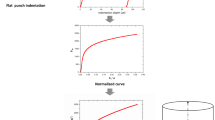Abstract
A fracture test is described in which square plates are supported near their corners and loaded concentrically. The maximum tensile stress occurs on the loading circle but appreciable tensile stresses exist at the mid-point of the plate edges. To minimize premature fracture here, due to edge damage in the plate, it is desirable to reduce the ratio edge stress: maximum stress in the plate. This can be achieved by moving the points of support inwards from the plate corners to the plate centre. A justification is presented for positioning the supports on a circle of diameterd s whered s/2a=0.85 and 2a is the length of the side of the plate. Loading diametersd 1 of valuesd 1/2a=0.25 andd 12a=0.075 are recommended. If the plates are thin conditions can be geometrically non-linear at the fracture load. In these circumstances membrane stresses develop in addition to the pure bending of the linear regime. Calculation of the relation between the load and the stresses in the plate must then be carried out, for example by the finite element method, for the specific conditions given in the test. However, this paper demonstrates that there is a useful range of conditions under which geometrical linearity persists up to the point of fracture. Under these circumstances it is shown that it is possible to generalize the relationship between the applied load at fracture and the plate stress distribution. This permits the fracture stress to be determined from the fracture load. The procedure for doing this is set out. It is also shown how, from the fracture load of the plate, the loading geometry and the elastic constants of the material can be established if it is permissible to use the linear solution to analyse the test. It is felt that this procedure might be helpful where there is no access to either finite element packages or to finite element expertise. The finite element packages used in the work now described in this paper are ABAQUS and LUSAS.
Similar content being viewed by others
References
K. M. Entwistle,J. Mater. Sci. 26 (1991) 1078.
Idem. ibid. 28 (1993) 2007.
C. J. Smithells (ed.) “Metals reference book”, 4th Edn (Butterworths, London, 1967) p. 708.
S. P. Timoshenko andS. Woinowsky-Krieger, “Theory of plates and shells”, 2nd Edn (McGraw Hill, Singapore, 1959) p. 48.
Author information
Authors and Affiliations
Rights and permissions
About this article
Cite this article
Entwistle, K.M. A fracture test using concentrically loaded square plates. J Mater Sci 30, 3773–3781 (1995). https://doi.org/10.1007/BF01153934
Received:
Accepted:
Issue Date:
DOI: https://doi.org/10.1007/BF01153934



